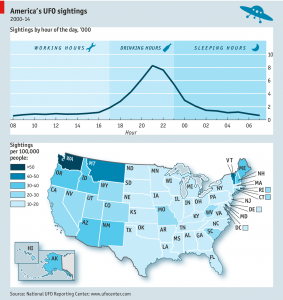Jul 01 2014
Distribution of UFO Sightings
 Scientists often take an epidemiological approach to a phenomenon to discover clues about its cause and nature. This is not limited to medical diseases, the basic concept can apply to any episodic event.
Scientists often take an epidemiological approach to a phenomenon to discover clues about its cause and nature. This is not limited to medical diseases, the basic concept can apply to any episodic event.
Take UFO sightings – the phenomenon in question is people reporting that they saw something unidentified in the sky. We can generate some basic hypotheses about factors that might influence UFO sightings: the presence of objects to be observed, viewing conditions, number of people available to make observations, and priming (the idea of UFOs in the culture, say following a movie about UFOs or a case reported in the media).
As reported by The Economist, the National UFO Reporting Center has released statistics on UFO sightings by state and by time of day. The Economist has conveniently placed this data in an infographic, depicted above. They helpfully labeled the three periods of the day as working hours, drinking hours, and sleeping hours. As you can see, UFO reports peak during the drinking hours.
I am going to assume the article is tongue-in-cheek, but it is being spread around social media, sometimes in a manner that seems credulous.
I don’t doubt the data itself, but the labeling of the chart amounts to begging the question – calling the evening hours the “drinking hours” makes certain assumptions about cause and effect. A far simpler explanation for the peak of sightings in the evening is that night-time conditions are more conducive to seeing unidentified lights in the sky, and people are still awake.
The article cheekily states that aliens don’t disturb us while we sleep (don’t tell that to people who experience hypnagogia and interpret the experience as an alien abduction), but obviously people are simply not in a position to make observations while they sleep.
Therefore we don’t need to invoke alcohol consumption at all to explain the pattern seen in this data.
There are, however, patterns in the UFO data that likely do provide genuine clues as to the nature of the UFO phenomenon. For example, UFO sightings tend to cluster near airforce bases. The US military, in fact, investigated sightings (because they were worried they were Soviet activity) and concluded that many were sightings of US spy planes.
UFO sightings also coincide with satellites, with the appearance of Venus in the sky, and with popular reports of UFO sightings. The recent popularity of floating lanterns has led to UFO sightings.
There is also a relationship between the details of UFOs and popular culture. People often report flying saucers, because that’s what UFOs are supposed to look like. There is an interplay between fiction and popular culture, each reinforcing the other. There is no particular reason to believe that alien spacecraft would resemble a flying saucer, and it would be quite a coincidence if they did.
Conclusion
Tomorrow, July 2, is UFO day, celebrating the anniversary of the alleged Roswell saucer crash (which really was nothing but a balloon and corner reflector spying on Soviet nuclear testing). Proponents want to raise awareness of UFOs. I think that’s a great idea – it’s an interesting psychological and cultural phenomenon.
As long as that awareness is honest about the state of the evidence and the most likely explanations for alleged UFO phenomena.
I don’t think that intoxication is a significant contributor to UFOs, and I don’t think The Economist was seriously suggesting this either. But there are plenty of terrestrial phenomena that can account for people seeing things they can’t readily identify, and there is no evidence that demands an extraterrestrial explanation.
I’m always open to such evidence. Whenever I write about UFOs, believers appear in the comments claiming that such evidence exists – but they can never produce it. Ever.






